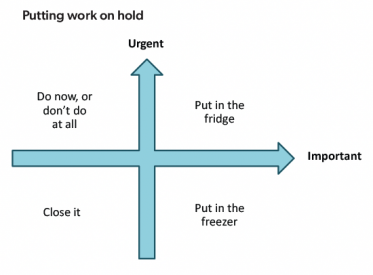Many agencies are putting work on hold while they focus on their COVID-19 responses, keeping staff safe, and putting business continuity into action.
One critical element that can easily be overlooked in this process is putting work to bed in a way that it can be easily picked back up again in future.
WHY DOES IT MATTER?
Pushing work to the back of the desk and neglecting it can result in one or more of the following outcomes:
While people are working from home, it can be a good idea to do some future planning, package up your work, and put a nice bow on it so that when someone picks it back up, it is tidy and ready to go again. Timing is everything – a programme that is attractive, easy to restart, and under control is vastly more likely to be successful than one that has people holding their noses or running for the hills. What sorts of things should we think about?
HAVE A PLAN
Know your deadlines, and work backwards to ensure you have identified when you must restart it. This will begin to tell you whether you can simply pick it back up, or will need to rescope, or need to renegotiate delivery dates.
Identify your priorities. Where does it fit within your agency’s priorities? Will these still be valid? Will budget priorities have changed, meaning you may need to review it? What will you need to do to get it back up running and visible?
Identify your risks. What happens if we do nothing? How can any risks be mitigated? Are there other projects that depend on this work (dependencies)?
Identify your stakeholders, and communicate, communicate, communicate. Tell them what you are doing, and why. And when they can expect to hear from you again. And stick to it and keep faith – this will preserve and even build relationships and understandings.
Identify the resources you will need when you do pick it back up. How will these be deployed? Will there be capacity? How will you ensure they are still available when you need to restart?
Be alert to opportunities. Will events make this work more relevant? Can it be reshaped to deliver even better value in a potentially new and different environment? Remember the old adage – good policy is 10% quality, 90% opportunity. The best idea can go nowhere if the timing isn’t right.
And finally - Document. Record where everything is at, and ensure this record sits on the top of any virtual or real folder.
WHAT ARE THE OPTIONS?
There may be many, but there are 4 main categories: Refrigerate, freeze, do, or stop. The diagram below sets out one way to think about them.

Put it in the fridge, with a “best before” date on it. This is work that is both important and urgent, and there will be expectations that it will get up and running once the current crisis is easing. The critical thing here is identifying key markers – when will the current work lose relevance? Or become more critical? You may need to make decisions at a point in time about the future. It may be that it is losing relevance – in which case put it in the freezer.
Put it in the freezer, with a “use-by” date on it. This is work that is still important, but a delay is not fatal – or not yet. Know when you will need to re-examine it, to identify whether it needs to be thawed, or, taken out and put out of its misery.
Put it out of its misery now. If work is not going to deliver future value (ie it is a “now” project) – or perhaps it never was going to, now is the time to quietly dispose of it. Tie off loose ends (eg any dependencies) and close it.
In all cases, tell your partners, stakeholders, and other parties with an interest what you are doing and why. Especially Ministers.
Download PDF
Sue Powell
Consulting Partner
THINGS THAT GO BUMP IN THE NIGHT…
Even with the best of processes and intentions, things can still go wrong. Beware ghost and zombie projects!
Ghost projects are those projects you put out of their misery, only to find the decision comes back to haunt you. This may mean that your stakeholders may have understood why you stopped something, but still hold the view that the work needs to be done. Remedy – engagement, and involvement in the decision about the fate of the project.
Zombie projects are the ones that just won’t die, no matter how many times you try to shoot them. These are more likely to be supported internally (possibly covertly) and may take a range of weapons to stop them. I.e. if silver bullets don’t work, try garlic, stakes through the heart, or better still, vaccinate against it. Burying never works. These things thrive in the underground.